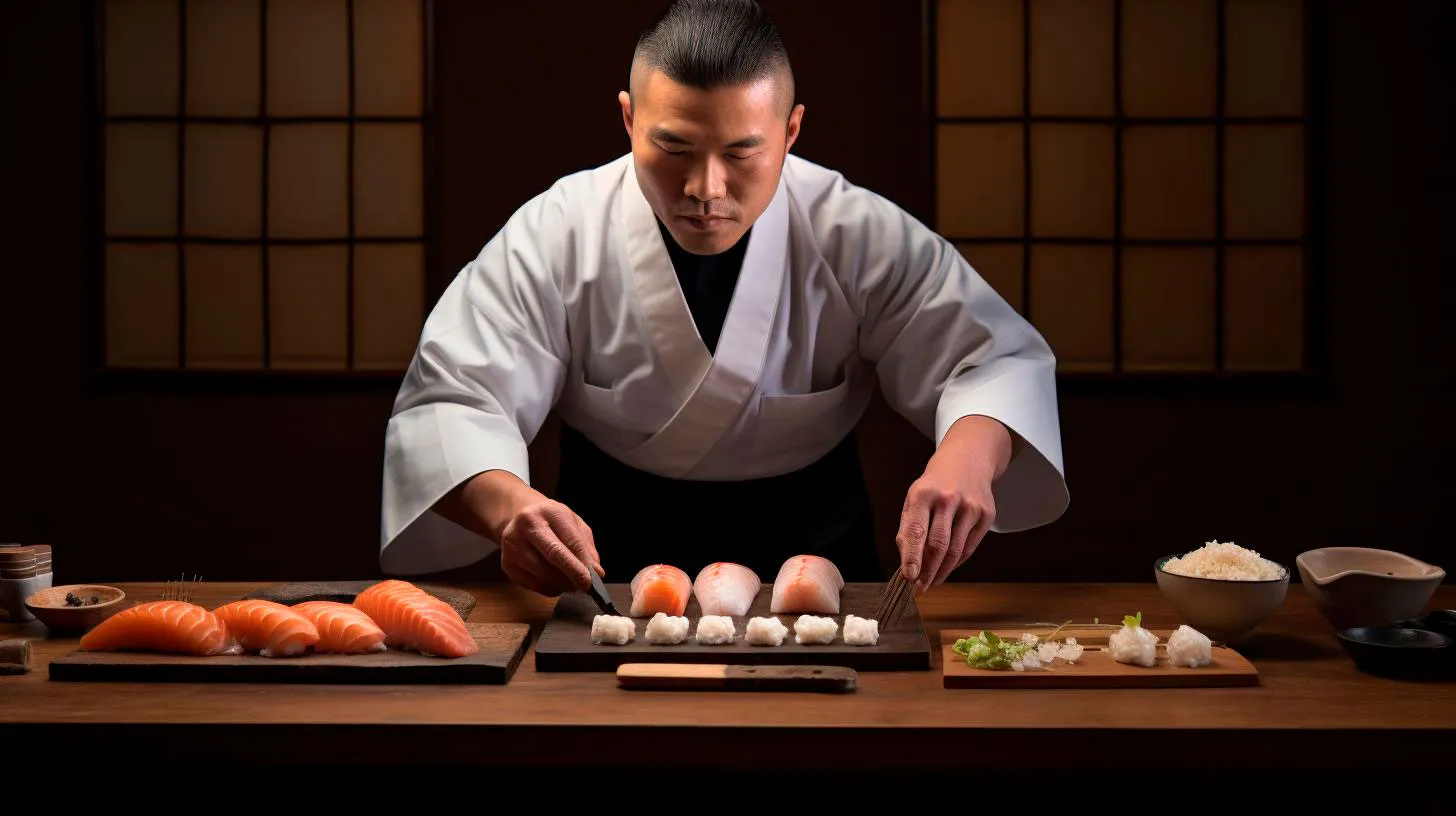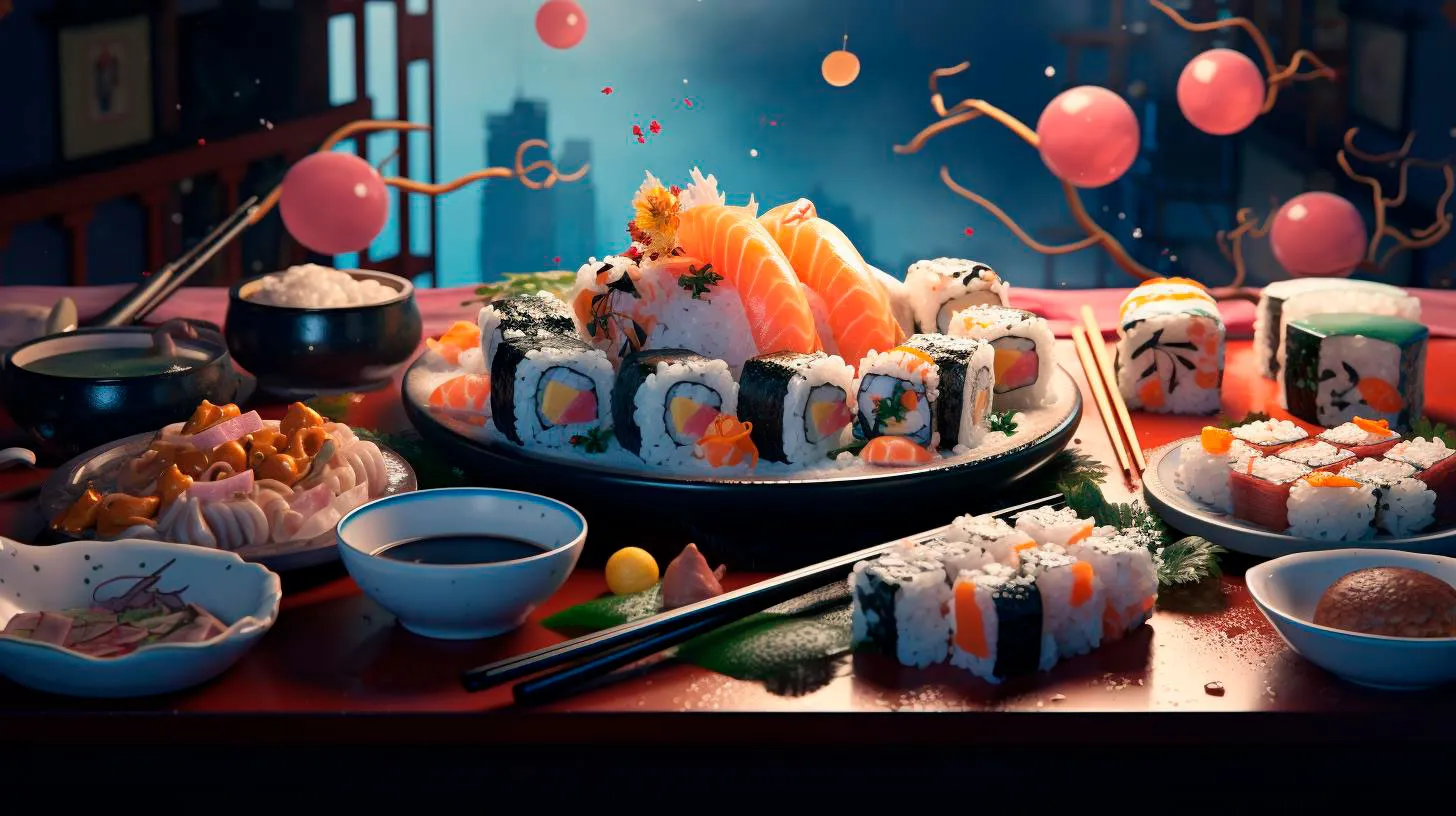Unveiling the Hidden Meanings: Decoding the Symbolism Behind Sushi Combinations
Each sushi combination is crafted with purpose, representing various cultural beliefs, traditions, and even superstitions. In this article, we will explore the intricate symbolism behind sushi combinations and uncover the fascinating stories they hold.
The Art of Sushi Combinations
Sushi combinations are not merely a random assortment of ingredients. Instead, they are meticulously designed to balance flavors, textures, colors, and even cultural nuances. The art of sushi-making is like a carefully choreographed dance, where each ingredient has a purpose and contributes to the overall experience.
Understanding the symbolism behind sushi combinations can help you appreciate the thought and craftsmanship that goes into every piece you savor. By deciphering the hidden meanings, you’ll gain insight into Japanese culture and tradition.
Essence of Simplicity: Nigiri Sushi
Nigiri sushi, which translates to “hand-pressed sushi,” is perhaps the most simple and straightforward form of sushi. It consists of a small mound of rice topped with a slice of fresh fish or seafood. Don’t let its minimalistic appearance deceive you; each component carries symbolic significance.
- The rice in nigiri sushi conveys purity and simplicity, symbolizing the staple food of the Japanese diet.
- The fish or seafood represents the varying seasons and the abundance of the ocean, infusing the dish with freshness and vitality.
By combining these elements, nigiri sushi is a harmonious blend of flavors and textures that reflect the balance found in nature.
Rolling with Tradition: Maki Sushi
Maki sushi, also known as sushi rolls, are cylindrical-shaped rolls made by wrapping nori (seaweed) around vinegared rice and various fillings. The symbolism behind maki sushi lies not only in its individual components but also in the act of rolling itself.
- The shape of maki sushi symbolizes harmony and unity.
- The nori, with its dark color, represents protection against evil spirits, bringing good luck to those who consume it.
- Fillings such as cucumber, avocado, and pickled vegetables contribute to the overall flavor profile and add a burst of vibrant colors, enhancing the visual appeal and freshness of the dish.
By embracing tradition and incorporating auspicious elements, maki sushi encapsulates the essence of Japanese culture and spirituality.
Delight in Variety: Sashimi
Sashimi refers to thinly sliced raw fish or seafood, served without rice. Although it might appear similar to nigiri sushi, sashimi offers a unique experience, showcasing the purity and quality of the ingredients themselves.
- Sashimi respects the integrity of the seafood, allowing its flavors and textures to take center stage.
- The presentation of sashimi is often artistic, enhancing the visual appeal and celebrating the beauty of simplicity.
Without the rice as a buffer, the freshness and quality of the fish become the primary focus, emphasizing the importance of sourcing top-notch ingredients.
The Power of Presentation
Japanese cuisine, including sushi, pays great attention to presentation. It is said that we eat with our eyes first, and sushi chefs understand the impact of visual aesthetics. Every sushi combination is carefully arranged to engage all our senses, creating a feast for both the eyes and taste buds.
- The vibrant colors of various ingredients represent the changing seasons and the connection between humans and nature.
- The meticulous arrangement of sushi pieces reflects the artistry and dedication of the sushi chef, as well as their desire to provide a memorable dining experience.
Understanding the significance of presentation enables us to appreciate the mastery and passion behind sushi-making, elevating the overall dining experience.
Key Takeaways:
- Sushi combinations are not random but hold deep cultural symbolism.
- Simplistic nigiri sushi balances purity and freshness.
- Maki sushi encompasses unity and protection against evil spirits.
- Sashimi celebrates the purity and quality of the ingredients.
- Japanese cuisine emphasizes visual aesthetics and sensory engagement.
As you savor your next plate of sushi, take a moment to appreciate the hidden meanings behind each combination. From the symbolism of rice and fish to the visual delights and cultural beliefs, sushi is much more than a culinary delight—it is an expression of art, tradition, and spirituality.
Unraveling the Secrets: Discover the Symbolic Meanings Behind Different Sushi Compositions
The Art of Sushi Composition
Sushi is more than just raw fish and rice; it encompasses the art of composition. Each sushi roll is meticulously crafted, using various ingredients that not only complement each other but also convey subtle meanings. Here, we delve into the symbolism of some popular sushi compositions:
Nigiri Sushi
Nigiri sushi consists of a small hand-formed mound of rice topped with a slice of raw fish or seafood. This classic sushi composition symbolizes simplicity, purity, and the unadulterated taste of the fish. The minimalism of nigiri allows the diner to focus on the exquisite flavor and texture of the fish itself.
Maki Sushi
Maki sushi, also known as sushi rolls, are created by wrapping rice and various ingredients with a sheet of seaweed called nori. The cylindrical shape of maki sushi symbolizes continuity and harmony. Each roll comprises unique combinations of ingredients, providing a burst of flavors with every bite.
Some popular maki sushi rolls include:
- California Roll: A fusion roll with avocado, cucumber, and crab meat, symbolizing the cultural diversity of California.
- Dragon Roll: Green-tinted sushi roll with shrimp tempura, cucumber, and sliced avocado, representing the mythical creature it is named after.
- Spicy Tuna Roll: A fiery roll filled with spicy tuna, symbolizing passion and exhilaration.
Temaki Sushi
Temaki sushi, also called hand-rolled sushi, is a cone-shaped sushi roll filled with rice, fish, and vegetables. Its shape symbolizes a cornucopia, representing abundance and prosperity. Temaki sushi offers a customizable experience, allowing diners to create their own unique combinations of fillings.
Chirashi Sushi
Chirashi sushi, meaning “scattered sushi,” is a bowl of sushi rice mixed with various toppings such as sashimi, vegetables, and garnishes. This composition represents the bountiful treasures of the sea and land. Chirashi sushi allows for an artistic arrangement of ingredients, creating an appealing visual presentation.
The Significance of Colors
Colors play a vital role in sushi composition as they evoke different emotions and have symbolic meanings. Here are some commonly used colors in sushi:
- Red: Symbolizes strength, power, and good fortune. Tuna, salmon, and red caviar are frequently used to represent these qualities.
- White: Signifies purity, cleanliness, and simplicity. White fish and scallops are often used for their delicate flavors.
- Green: Represents freshness, growth, and harmony. Ingredients like avocado, cucumber, and shiso leaves provide a vibrant green hue.
- Black: Conveys mystery, elegance, and sophistication. Squid ink and black sesame seeds are incorporated to add depth to sushi compositions.
The Key Takeaways
Unveiling the symbolism behind different sushi compositions offers a unique perspective on this beloved Japanese cuisine. By understanding the artistry behind each roll, we can appreciate the hidden messages conveyed through the careful arrangement of ingredients.
- Every sushi composition has a symbolic meaning, conveying messages beyond taste and texture.
- Nigiri sushi represents simplicity and the raw essence of the fish, allowing its flavors to take center stage.
- Maki sushi rolls symbolize continuity and harmony while providing an explosion of flavors with every bite.
- Temaki sushi offers a customizable, cornucopia-like experience, symbolizing abundance and prosperity.
- Chirashi sushi represents the bountiful treasures of the sea and land, showcasing varied ingredients arranged artistically.
- Colors in sushi compositions evoke emotions and convey symbolism. Red signifies power and good fortune, while white represents purity and simplicity.
Next time you enjoy sushi, savor not only the flavors but also the rich symbolism behind each meticulously crafted composition. Dive into the artistry and unlock the hidden meanings within this iconic Japanese cuisine.
Sushi Symbolism: Exploring the Cultural Significance of Different Sushi Ingredients
In this blog article, we will explore the symbolism behind different sushi ingredients, giving you a deeper appreciation for this culinary art.
The Symbolic Journey of Sushi Ingredients
Sushi is more than just raw fish and rice. It is a reflection of Japanese culture, tradition, and even spirituality. Let’s dive into the symbolic journey of sushi ingredients:
1. Rice: The Foundation of Sushi
Rice, meticulously seasoned with vinegar, sugar, and salt, forms the base of sushi. Symbolically, the rice represents the stability and foundation of Japanese society. The perfectly formed rice ball showcases the precision and attention to detail that Japanese culture values.
Key Takeaways:
- Rice symbolizes stability and the foundation of Japanese society.
- Precision and attention to detail are essential in perfecting sushi rice.
- The combination of vinegar, sugar, and salt adds flavor and balance to the dish.
2. Fish: Respecting Nature’s Bounty
When it comes to sushi, fish plays a crucial role. Freshness is of utmost importance as it ensures the quality and taste. The fish used in sushi showcases the Japanese appreciation for nature’s bounty. Furthermore, different types of fish carry their own symbolism:
- Salmon represents perseverance and determination, swimming upstream against the current.
- Tuna symbolizes strength and vitality due to its powerful nature.
- Hamachi (yellowtail) signifies harmony as it smoothly blends with other ingredients.
Key Takeaways:
- Fresh fish underscores the importance of quality and taste in sushi.
- Each fish variety carries its own symbolism.
- Salmon represents perseverance, tuna symbolizes strength, and hamachi signifies harmony.
3. Seafood and Shellfish: Embracing Oceanic Heritage
Seafood and shellfish, such as shrimp, squid, and octopus, are commonly used in sushi. These ingredients represent Japan’s deep connection to the ocean and its bountiful offerings. In Japanese culture, seafood symbolizes purity, fertility, and abundance.
Key Takeaways:
- Seafood and shellfish embody Japan’s connection to the ocean and its abundant resources.
- These ingredients symbolize purity, fertility, and abundance.
4. Vegetables: Adding Color and Symbolism
Sushi is not limited to just fish and seafood. Vegetables also play a significant role, adding color, texture, and symbolism to the dish. The most common vegetable used in sushi is cucumber, representing freshness and vitality.
Key Takeaways:
- Vegetables bring color, texture, and added symbolism to sushi.
- Cucumber, the most popular vegetable used in sushi, symbolizes freshness and vitality.
The Cultural Significance of Sushi Ingredients
Beyond their individual symbolism, sushi ingredients collectively represent the values and traditions ingrained in Japanese culture:
- Simplicity: Sushi embraces minimalism, allowing each ingredient to shine.
- Seasonality: Traditional sushi revolves around seasonal ingredients, highlighting the importance of harmony with nature.
- Precision: The art of crafting sushi requires precision and attention to detail.
- Purity: Sushi symbolizes the importance of purity, both in the ingredients and the preparation process.
Conclusion
Sushi is not just a meal; it is a cultural experience steeped in symbolism. By understanding the significance of different sushi ingredients, we gain a deeper appreciation for the culinary art form and the values it represents. From the stability of rice to the freshness of fish and the vibrancy of vegetables, every aspect of sushi tells a story about Japanese culture and tradition.
So, next time you indulge in sushi, savor not only the flavors but also the deeper symbolism behind each bite.
Delve into the Significance: Understanding the Symbolism of Sushi Ingredient Pairings
The art of sushi making involves careful consideration of ingredient pairings, which hold deep cultural and symbolic significance. In this article, we will explore the hidden meanings behind sushi ingredient pairings and uncover the secrets behind this revered culinary tradition.
The Art of Sushi Ingredient Pairings
Sushi making is an art form that goes beyond mere culinary skills. Each sushi roll is a carefully crafted composition, where the combination of ingredients is essential. The art of ingredient pairing in sushi aims to achieve a harmonious blend of flavors, textures, and colors, while also celebrating the seasonal produce. Here are some key aspects that contribute to the significance of sushi ingredient pairings:
- Balance: The balance of flavors is crucial in sushi. Each ingredient, whether it’s the fish, rice, or condiments, should complement and enhance one another. The goal is to create a well-rounded and satisfying taste profile.
- Contrast: Sushi ingredient pairings often involve contrasting flavors and textures. The delicate flavor of a slice of raw fish is balanced with the creaminess of avocado or the crunchiness of vegetables. These contrasts create a multi-dimensional experience for the palate.
- Seasonality: Traditional sushi embodies the concept of seasonality. The selection of seasonal ingredients not only ensures the freshest flavors but also pays homage to the changing seasons. This connection to nature is a fundamental aspect of Japanese culture.
The Symbolism of Sushi Ingredient Pairings
Japanese cuisine has a rich history and is deeply rooted in symbolism. Sushi is no exception. Each ingredient used in sushi has its own symbolic meaning, and when combined, they create a greater story. Here are some examples of sushi ingredient pairings and their symbolic significance:
Toro (Fatty Tuna) and Scallions
The combination of toro, a highly prized fatty tuna, and scallions is a classic pairing in sushi. The rich and buttery flavor of toro symbolizes indulgence and luxury, while the sharpness of scallions adds a refreshing contrast. This combination represents the balance between decadence and simplicity.
Salmon and Ikura (Salmon Roe)
Salmon and ikura are often paired together to create a visually striking and flavorful combination. Salmon represents strength and resilience, while the vibrant orange ikura symbolizes abundance and fertility. This pairing signifies prosperity and good fortune.
Uni (Sea Urchin) and Shiso (Perilla Leaf)
The pairing of uni, a delicacy known for its rich and creamy texture, with shiso, a pungent and aromatic leaf, creates a unique flavor profile. Uni represents elegance and sophistication, while shiso adds a touch of freshness. Together, they create a harmonious balance of bold and subtle flavors.
The Key Takeaways
Understanding the symbolism behind sushi ingredient pairings adds a new layer of appreciation to this beloved culinary art. Here are the key takeaways to remember:
- Ingredient pairings in sushi aim for balance, contrast, and seasonality.
- Sushi ingredient pairings have deep cultural and symbolic significance.
- Each ingredient used in sushi brings its own meaning, which contributes to the overall composition.
- Exploring the world of sushi ingredient pairings allows us to delve into Japanese culture and traditions.
Next time you indulge in the delicate flavors of sushi, take a moment to appreciate the artistry and symbolism behind each ingredient pairing. It’s not just a meal; it’s a cultural experience.


